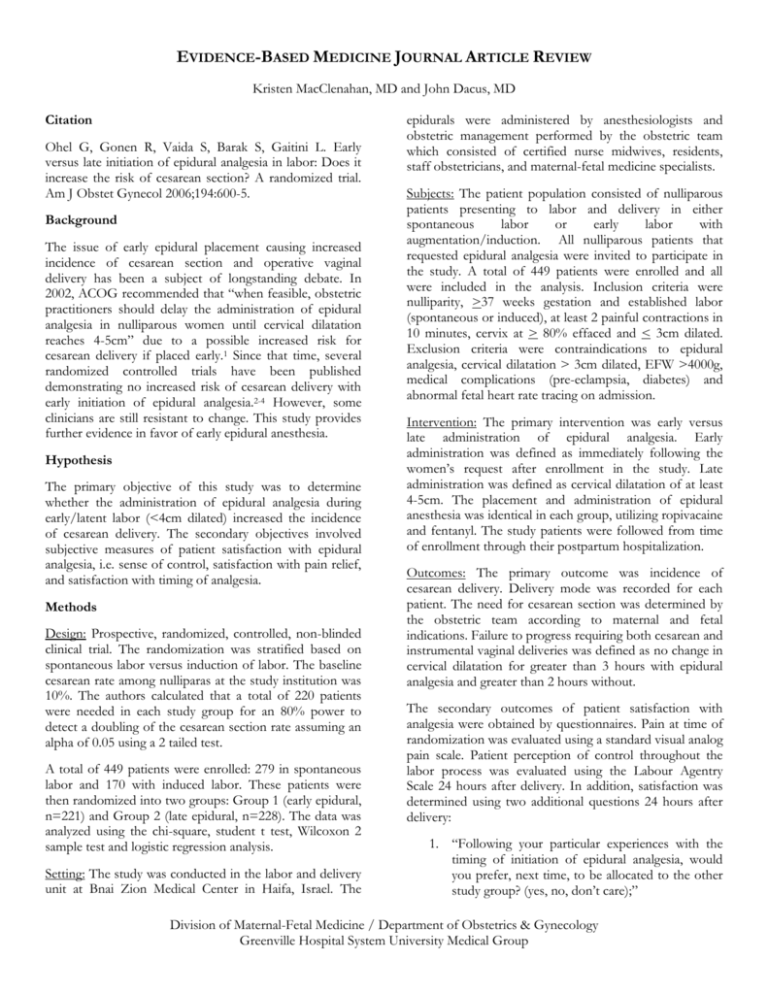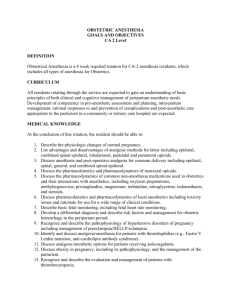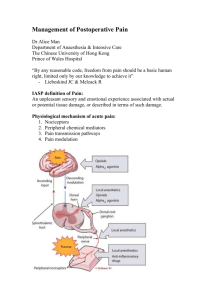MS Word - nuthalapaty.net
advertisement

EVIDENCE-BASED MEDICINE JOURNAL ARTICLE REVIEW Kristen MacClenahan, MD and John Dacus, MD Citation Ohel G, Gonen R, Vaida S, Barak S, Gaitini L. Early versus late initiation of epidural analgesia in labor: Does it increase the risk of cesarean section? A randomized trial. Am J Obstet Gynecol 2006;194:600-5. Background The issue of early epidural placement causing increased incidence of cesarean section and operative vaginal delivery has been a subject of longstanding debate. In 2002, ACOG recommended that “when feasible, obstetric practitioners should delay the administration of epidural analgesia in nulliparous women until cervical dilatation reaches 4-5cm” due to a possible increased risk for cesarean delivery if placed early.1 Since that time, several randomized controlled trials have been published demonstrating no increased risk of cesarean delivery with early initiation of epidural analgesia.2-4 However, some clinicians are still resistant to change. This study provides further evidence in favor of early epidural anesthesia. Hypothesis The primary objective of this study was to determine whether the administration of epidural analgesia during early/latent labor (<4cm dilated) increased the incidence of cesarean delivery. The secondary objectives involved subjective measures of patient satisfaction with epidural analgesia, i.e. sense of control, satisfaction with pain relief, and satisfaction with timing of analgesia. Methods Design: Prospective, randomized, controlled, non-blinded clinical trial. The randomization was stratified based on spontaneous labor versus induction of labor. The baseline cesarean rate among nulliparas at the study institution was 10%. The authors calculated that a total of 220 patients were needed in each study group for an 80% power to detect a doubling of the cesarean section rate assuming an alpha of 0.05 using a 2 tailed test. A total of 449 patients were enrolled: 279 in spontaneous labor and 170 with induced labor. These patients were then randomized into two groups: Group 1 (early epidural, n=221) and Group 2 (late epidural, n=228). The data was analyzed using the chi-square, student t test, Wilcoxon 2 sample test and logistic regression analysis. Setting: The study was conducted in the labor and delivery unit at Bnai Zion Medical Center in Haifa, Israel. The epidurals were administered by anesthesiologists and obstetric management performed by the obstetric team which consisted of certified nurse midwives, residents, staff obstetricians, and maternal-fetal medicine specialists. Subjects: The patient population consisted of nulliparous patients presenting to labor and delivery in either spontaneous labor or early labor with augmentation/induction. All nulliparous patients that requested epidural analgesia were invited to participate in the study. A total of 449 patients were enrolled and all were included in the analysis. Inclusion criteria were nulliparity, >37 weeks gestation and established labor (spontaneous or induced), at least 2 painful contractions in 10 minutes, cervix at > 80% effaced and < 3cm dilated. Exclusion criteria were contraindications to epidural analgesia, cervical dilatation > 3cm dilated, EFW >4000g, medical complications (pre-eclampsia, diabetes) and abnormal fetal heart rate tracing on admission. Intervention: The primary intervention was early versus late administration of epidural analgesia. Early administration was defined as immediately following the women’s request after enrollment in the study. Late administration was defined as cervical dilatation of at least 4-5cm. The placement and administration of epidural anesthesia was identical in each group, utilizing ropivacaine and fentanyl. The study patients were followed from time of enrollment through their postpartum hospitalization. Outcomes: The primary outcome was incidence of cesarean delivery. Delivery mode was recorded for each patient. The need for cesarean section was determined by the obstetric team according to maternal and fetal indications. Failure to progress requiring both cesarean and instrumental vaginal deliveries was defined as no change in cervical dilatation for greater than 3 hours with epidural analgesia and greater than 2 hours without. The secondary outcomes of patient satisfaction with analgesia were obtained by questionnaires. Pain at time of randomization was evaluated using a standard visual analog pain scale. Patient perception of control throughout the labor process was evaluated using the Labour Agentry Scale 24 hours after delivery. In addition, satisfaction was determined using two additional questions 24 hours after delivery: 1. “Following your particular experiences with the timing of initiation of epidural analgesia, would you prefer, next time, to be allocated to the other study group? (yes, no, don’t care);” Division of Maternal-Fetal Medicine / Department of Obstetrics & Gynecology Greenville Hospital System University Medical Group EVIDENCE-BASED MEDICINE JOURNAL ARTICLE REVIEW, CONTINUED 2. “Were you satisfied with the epidural analgesia? (yes, no or partially satisfied).’” Additional secondary outcomes assessed were incidence of operative vaginal deliveries, neonatal outcomes, incidence of maternal fever, meconium, and time from randomization to full dilatation, and need for oxytocin augmentation. Since the outcomes were all measured during the hospitalization, follow up was complete for all patients. randomized. Both groups were similar at the initiation of the trial with respect to demographics, BMI, initial cervical dilatation, rupture of membranes, cervical effacement, initial pain score, gestational age, and birth weight. The groups were treated equally throughout the study course except for the timing of epidural analgesia. The outcomes measured were objectified and data analysis was completed using intention to treat, including all patients. The only source of possible bias which might affect validity was the non-blinded nature of the study. Results Recommendation No difference between rate of cesarean section (13% early, 11% late (p=0.77) and rate of instrumental vaginal delivery (17% early, 19% late (p=0.63) was detected. A shorter duration from time of randomization to full dilatation was observed in the early group compared to the late group (5.9 vs. 6.6 respectively (p=0.04)). In addition, no difference in duration of second stage of labor, neonatal outcomes, rate of maternal fever, or need for oxytocin augmentation was found. The results of this study are clinically useful. In major labor and delivery suites, most patients elect to receive epidural analgesia if it is readily available. Therefore, timing of epidural placement is an issue that is addressed on a daily basis. This study supports earlier investigations that suggest that early placement of epidural is not associated with a statistically significant increase in the incidence of cesarean or operative delivery. Therefore, clinicians should consider responding to requests for epidural analgesia regardless of the stage of labor. Patient preference to be placed in the early epidural group for future deliveries was found to be significant (p<0.0001); however, no difference with satisfaction of analgesia once administered was appreciated. Commentary This study was not the first randomized controlled trial to compare obstetric outcomes with timing of epidural anesthesia. The first randomized trial conducted by Chestnut et al in 1994 demonstrated no difference in time to complete dilatation, incidence of cesarean delivery, or need for operative vaginal delivery in nulliparous patients both in spontaneous labor and those undergoing oxytocin augmentation.1,2 A subsequent randomized controlled trial published by Wong et al in 1995, compared early verses late epidural in nulliparous patients and again confirmed no difference in cesarean or operative delivery rates.4 Ohel’s study is only the third randomized trial since 1994 to readdress the issue of epidural timing and obstetric outcomes. This study met ethical criteria and was approved by the local ethics committee at the participating study site. The patients were enrolled after informed consent and they were offered alternative analgesics while awaiting epidural placement. The methodology of this study was sound and the results were valid. The design was a randomized controlled trial, follow up was complete, all patients enrolled were accounted for in the statistical analyses, and all patients were analyzed in the groups to which they were References 1. ACOG Practice Bulletin. Obstetric analgesia and anesthesia. 2002; No 36:177-191. 2. Chestnut et al. Does early administration of epidural analgesia affect obstetric outcome in nulliparous women who are receiving intravenous oxytocin? Anesthesiology 1994;80:1193-1200. 3. Chestnut et al. Does early administration of epidural analgesia affect obstetric outcome in nulliparous women who are in spontaneous labor? Anesthesiology 1994;80:1201-1208. 4. Wong et al. The risk of cesarean delivery with neuraxial analgesia given early versus late in labor. N Eng J Med 2005;352:655-665. 5. Guyatt GH, Sackett DL, Cook DJ. Users’ guides to the medical literature. How to use an article about therapy or prevention. Are the results of the study valid? JAMA 1993;271:2598-2601. 6. Greenhalgh T. How to read a paper. The basics of evidence based medicine. 2nd ed. London, UK: BMJ books. Pg 47-50; 59-66. 7. Guyatt GH, Sackett DL, Cook DJ. Users’ guides to the medical literature. How to use an article about therapy or prevention. What were the results and will they help me in caring for my patients? JAMA 1994;271: 59-63. 8. Dans AL, Dans LF, Guyatt GH, Richardson S. Users’ guides to the medical literature. How to decide on the applicability of clinical trial results to your patient. JAMA 1998;279:545-549. Division of Maternal-Fetal Medicine / Department of Obstetrics & Gynecology Greenville Hospital System University Medical Group









